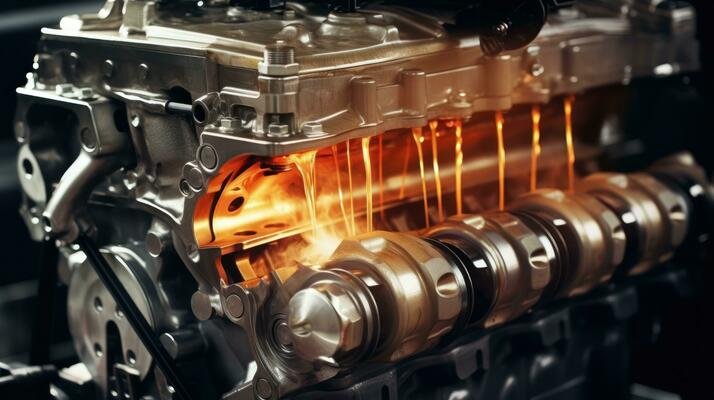

Understanding Your Engine’s Temperature: Stay Cool, Run Smooth
The engine in your car is a remarkable piece of engineering, but, like any machine, it produces heat during operation. Maintaining this heat within a safe range is essential for peak performance and avoiding potential damage. So, what temperature threshold indicates a problematic level for your engine?
Normal Operating Range:
In automotive engineering, the temperature dynamics within an engine’s operating environment are carefully monitored and optimized. Across the spectrum of modern vehicles, it’s a common sight to witness engines gracefully navigating within a temperature range that typically spans from 195°F to 220°F (approximately 90°C to 104°C). Within this operational band, a delicate balance is struck, facilitating efficient combustion, optimal lubrication, and effective emissions control.
It’s fascinating to note the intricate choreography happening under the hood as the engine functions within this specified thermal window. At the lower end of the spectrum, around 195°F (90°C), the engine is just warming up, allowing components to expand slightly and reach their ideal operating dimensions. As the temperature climbs towards the higher end of the range, reaching around 220°F (104°C), the combustion process achieves peak efficiency, translating into optimal power output and fuel economy.
Beyond the technical nuances, maintaining this temperature range is crucial for the engine’s longevity and overall health. Operating too far below the lower threshold can lead to incomplete combustion, increased friction, and inefficient lubrication, while surpassing the upper limit risks overheating, potentially causing damage to vital components like gaskets, seals, and even the engine block itself.
Furthermore, adherence to this temperature range is not just a matter of performance but also environmental responsibility. Efficient combustion and emissions control mechanisms function optimally within this zone, ensuring that your vehicle meets regulatory standards while minimizing its ecological footprint. In essence, the temperature range within which modern engines operate is not merely a numerical figure but a testament to the intricate interplay of engineering, chemistry, and thermodynamics, all working in harmony to propel us forward with efficiency, reliability, and environmental consciousness.
Danger Zone:
Venturing beyond the prescribed temperature range for an extended period can thrust your engine into the perilous realm of overheating, a scenario fraught with potential consequences. Manifestations of overheating are often glaringly evident, with telltale signs such as skyrocketing temperature gauge readings, wisps of steam billowing from beneath the hood, and a palpable decrease in engine power.
When the engine’s temperature gauge needle veers into the red zone or climbs abnormally high, it’s a clear indicator of trouble brewing under the hood. This deviation from the norm signals that the engine’s cooling system is struggling to dissipate heat effectively, prompting a cascade of adverse effects. The sight of steam emanating from the engine compartment is a visual testament to the excess heat attempting to escape. This steam, often accompanied by a distinct odor of coolant, serves as an unmistakable warning that the engine is operating in a perilous state of overheating.
Furthermore, the consequences of overheating extend beyond mere inconvenience, as the engine’s performance is measurably impacted. With rising temperatures, the engine’s efficiency dwindles, resulting in a noticeable reduction in power output. Acceleration becomes sluggish, and the vehicle may struggle to maintain speed, all symptomatic of the engine’s compromised state.
Left unchecked, prolonged exposure to overheating can inflict severe damage to critical engine components. Gaskets may fail, leading to coolant leaks and potential coolant loss. The engine block itself may warp or crack under the strain of excessive heat, culminating in catastrophic failure and necessitating costly repairs or even engine replacement. In essence, surpassing the recommended temperature range isn’t merely a matter of inconvenience; it’s a red flag signaling imminent danger to your vehicle’s well-being. Recognizing the symptoms of overheating and taking prompt corrective action can spare you from the perils of engine damage and ensure the continued smooth operation of your vehicle on the road.
Melting Point Mayhem:
Persisting beyond the established temperature boundaries can unleash a cascade of catastrophic consequences, culminating in a phenomenon I like to call “Melting Point Mayhem.” When temperatures soar unchecked, the integrity of critical engine components, such as pistons, rings, and bearings, is jeopardized, exposing them to the peril of warping or even melting.
Pistons, typically crafted from aluminum alloys, are particularly vulnerable to the ravages of excessive heat. When subjected to temperatures beyond their design limits, these vital engine components can deform, lose their structural integrity, and ultimately fail catastrophically. Rings, tasked with maintaining compression within the combustion chamber, may succumb to the intense heat, losing their ability to seal effectively and compromising engine performance.
The plight doesn’t end there. Bearings, essential for reducing friction and facilitating smooth rotation within the engine, are also susceptible to the searing heat. Overheating can cause these bearings to seize or degrade rapidly, resulting in abrasive wear, increased friction, and potential catastrophic failure of the engine’s moving parts. The consequences of Melting Point Mayhem extend far beyond mere inconvenience, heralding a symphony of costly repairs and, in severe cases, outright engine failure. Engine rebuilds or replacements become an unfortunate necessity, accompanied by a hefty price tag and a significant disruption to your automotive endeavors.
In essence, venturing into the realm of Melting Point Mayhem is akin to dancing with the devil, inviting the specter of irreparable damage and financial turmoil. Vigilance, adherence to recommended temperature limits, and prompt intervention at the first signs of overheating are your best defenses against this perilous fate, ensuring the continued health and longevity of your engine for miles to come.

Factors Affecting the Heat:
External temperature fluctuations wield a significant influence on your engine’s cooling system, particularly during scorching summers or in climates with consistently high temperatures. When the mercury rises, the cooling system must work overtime to dissipate heat effectively, placing additional strain on its components and potentially pushing the engine’s temperature towards the upper limits.
Moreover, driving conditions exert a tangible impact on your engine’s thermal management. Stop-and-go traffic, common in urban settings, restricts airflow through the radiator, hindering the cooling process and allowing heat to accumulate within the engine bay. Similarly, tasks like towing heavy loads or conquering steep uphill climbs demand more power from the engine, consequently generating higher levels of heat that must be promptly dissipated.
The overall health of your engine also factors into its temperature regulation capabilities. Worn-out components, such as malfunctioning water pumps or deteriorated hoses, can impede the circulation of coolant, diminishing the system’s ability to maintain optimal temperatures. Low coolant levels pose a similar threat, reducing the fluid’s capacity to absorb and transfer heat away from critical engine components. Additionally, neglected maintenance tasks, like dirty air filters or clogged radiators, can impair airflow and compromise cooling efficiency, exacerbating the risk of overheating.
Equally critical is the role played by the coolant itself. The type and condition of the coolant circulating through your engine’s veins are paramount. Proper coolant selection, tailored to your vehicle’s specifications and environmental conditions, ensures optimal thermal conductivity and corrosion protection. Regular coolant flushes and replenishments safeguard against coolant degradation and maintain its heat-dissipating properties, thereby preserving the engine’s temperature equilibrium.
In essence, a myriad of factors, from external temperatures and driving conditions to engine health and coolant efficiency, converge to influence your engine’s thermal equilibrium. By remaining vigilant, addressing maintenance needs promptly, and selecting the appropriate coolant for your vehicle’s requirements, you can bolster the cooling system’s resilience and safeguard against the perils of overheating, ensuring smooth and trouble-free journeys ahead.
Keeping Your Engine Cool:
Routine maintenance is the cornerstone of engine health and longevity. Adhering to your manufacturer’s prescribed maintenance schedule ensures that vital fluids are changed, filters are replaced, and cooling system components are inspected regularly. By following these guidelines, you can proactively address potential issues before they escalate, maintaining your engine’s efficiency and reliability over the long haul. Monitoring your temperature gauge is crucial in detecting early signs of overheating. Any deviation from the normal operating range should be addressed promptly to prevent further complications. Ignoring warning signs could lead to more severe damage and costly repairs down the line.
Regularly checking your coolant level and ensuring the correct mixture are fundamental steps in maintaining optimal engine performance. Coolant serves as a vital component in regulating engine temperature, so it’s essential to keep it at the appropriate level and concentration. Maintaining clean airflow through your radiator and air filters is paramount for effective heat dissipation. Over time, dirt, debris, and contaminants can accumulate, obstructing airflow and impeding the cooling process. Regular inspection and cleaning of these components will help ensure proper engine cooling.
Where feasible, it’s advisable to avoid subjecting your vehicle to strenuous conditions that can exacerbate heat buildup. This includes activities like towing heavy loads or prolonged idling, especially in hot weather. Minimizing these stressors on your engine can help prevent overheating and prolong its lifespan.
Add a comment Cancel reply
Categories
- Car Gadgets (17)
- Car News (33)
- Car Reviews (43)
- Car Wars (7)
- Mechanicals (32)
- Uncategorized (2)
Recent Posts
About us

Popular Tags
Related posts


Essential Car Repair Skills Every Driver Should Know

All About Wheel Balancing








